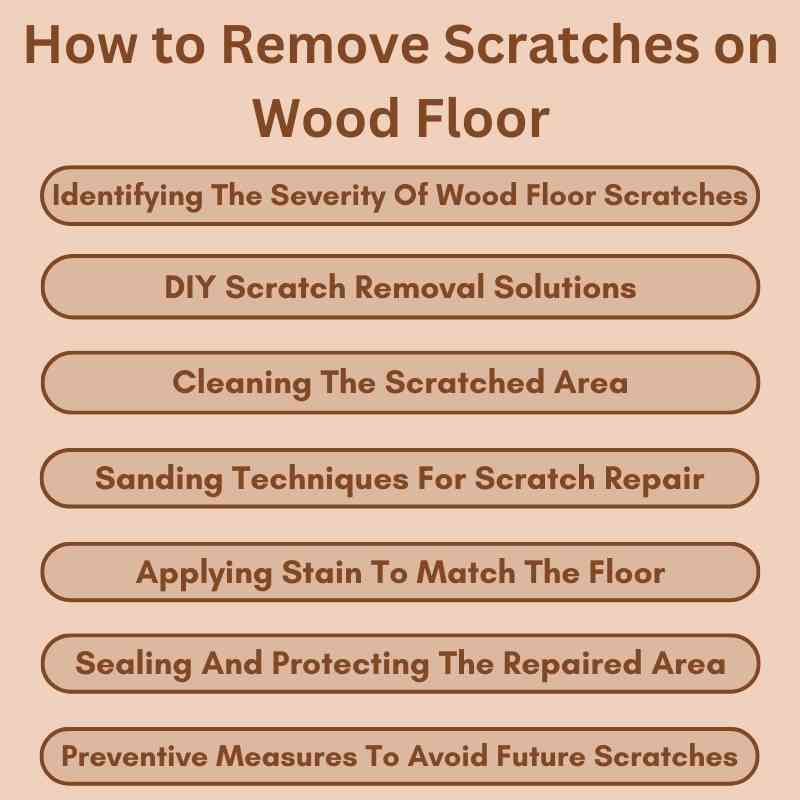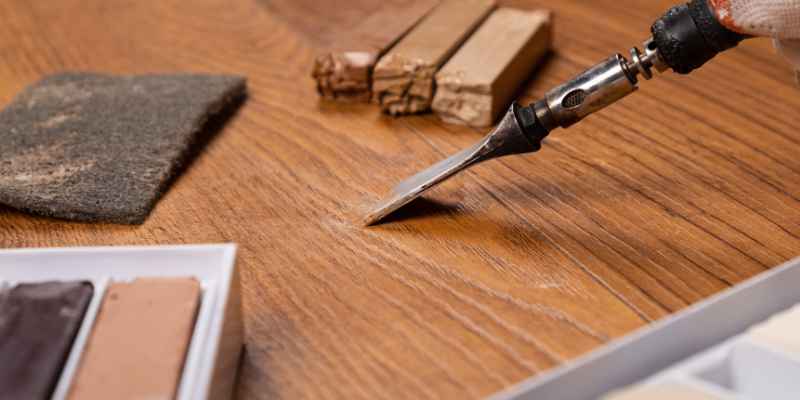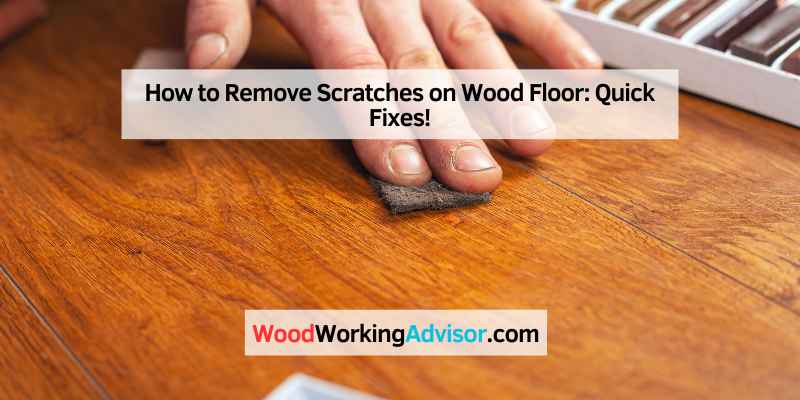To remove scratches on a wood floor, mix equal parts apple cider vinegar and olive oil in a small cup, dab the solution into the scratches, leave it for a day, and then rub it out with a clean, soft cloth. This method works best for small scratches on a relatively new finish.
For deeper gouges and scratches, wood filler, sanding, and refinishing techniques are the most effective solutions. It’s important to choose the method that best suits the depth and severity of the scratches to restore the wood floor’s appearance and integrity.
Wood floors add natural beauty and warmth to any space, but scratches can detract from their aesthetic appeal. Whether the scratches are minor surface marks or deep gouges, knowing how to effectively remove them is essential for maintaining the floor’s appearance and ensuring its longevity. We will explore various methods and techniques for removing scratches from wood floors, allowing you to restore the floor’s natural beauty and luster.
Identifying The Severity Of Wood Floor Scratches
Minor Vs. Major Scratch Damage
Minor scratches on wood floors are superficial and only affect the surface finish. These scratches are typically shallow and can be treated with simple DIY methods. On the other hand, major scratches penetrate the wood and may even expose the bare wood, requiring more intensive repair.
When To Call A Professional
If you notice deep or extensive scratches that are beyond the scope of DIY repair, it’s advisable to seek professional assistance. A skilled wood floor technician can assess the damage accurately and recommend the most suitable repair options.

DIY Scratch Removal Solutions
Discover effective DIY scratch removal solutions for wood floors. Mix apple cider vinegar and olive oil to dab on small scratches, or use wood filler for deeper gouges. Sand and refinish for a polished finish without sanding.
Hardwood floors add a touch of elegance to any room, but scratches on the floor can quickly ruin its look. Fortunately, there are several DIY scratch removal solutions that you can try before calling in a professional. In this post, we will discuss two effective methods – Vinegar and Olive Oil Method and Using Wood Filler for Deeper Gouges.
Vinegar and Olive Oil Method
If you have small scratches on your hardwood floor, you can try the Vinegar and Olive Oil Method. Here are the steps you need to follow:
1. Mix equal parts of apple cider vinegar and olive oil in a small cup.
2. Dip a soft cloth in the mixture and carefully dab the solution into the scratches.
3. Leave the solution in the scratches for a day.
4. Rub it out with a clean, soft cloth.
This method works best for small scratches and is not recommended for deeper gouges.
Using Wood Filler for Deeper Gouges
For deeper gouges and scratches on hardwood floors, you will need to use wood filler. Here are the steps you need to follow:
1. Clean the area around the scratch with a damp rag and let it dry.
2. Apply the wood filler to the scratch with a putty knife and let it dry as per the manufacturer’s instructions.
3. Sand the area lightly with fine-grit sandpaper until it is smooth.
4. Stain the area to match the rest of the floor.
5. Apply a polyurethane finish to protect the area.
This method is more time-consuming but is effective for deeper gouges and scratches.
Conclusion
Try these DIY scratch removal solutions before calling in a professional. Remember, prevention is always better than cure, so try to avoid scratches on your hardwood floors by using furniture pads and avoiding sharp objects on the floor.
Cleaning The Scratched Area
To remove scratches on wood floors, start by cleaning the scratched area with a damp rag. For deeper scratches, apply a wood putty and sand smooth. Then, apply a fresh coat of polyurethane. You can also mix equal parts apple cider vinegar and olive oil and dab the solution into small scratches, leaving it for a day before rubbing it out with a soft cloth.
Murphy Oil Soap can also be used to remove stains and scratches from waxed floors.
When it comes to cleaning the scratched area on your wood floor, it’s important to follow proper techniques for safe cleaning. Choosing the right cleaning products is crucial to ensure you don’t cause further damage to the floor. Here are some tips to help you clean the scratched area effectively:
Proper Techniques For Safe Cleaning
1. Lightly moisten a soft cloth or sponge with water and gently wipe the scratched area. This will help remove any loose dirt or debris that may be present.
2. Avoid using abrasive cleaning tools, such as steel wool or scrub brushes, as they can further damage the wood surface.
3. For stubborn stains or dirt, mix a mild wood floor cleaner with water according to the manufacturer’s instructions. Apply the solution to a clean cloth and gently rub the scratched area in a circular motion.
4. Be cautious not to oversaturate the wood floor with water or cleaning solution, as excessive moisture can cause warping or swelling.
Choosing The Right Cleaning Products
When selecting cleaning products for your wood floor, it’s important to choose ones that are specifically designed for use on hardwood. Here are some options to consider:
| Product | Description |
|---|---|
| Wood floor cleaner | Avoid using generic household cleaners, as they may contain harsh chemicals that can damage the wood finish. Opt for a cleaner specifically formulated for hardwood floors. |
| Vinegar and water solution | Mixing equal parts of white vinegar and water can create a natural, homemade cleaning solution that is safe for wood floors. However, be cautious not to use too much vinegar, as it can strip the finish over time. |
| Microfiber mop | Using a microfiber mop is an effective way to clean wood floors without causing scratches. The soft microfiber material traps dirt and dust, preventing them from scratching the surface. |
Remember to always test any cleaning product or solution on a small, inconspicuous area of the floor before applying it to the scratched area. This will help ensure that the product doesn’t cause any adverse effects or discoloration.
By following these proper techniques for safe cleaning and choosing the right cleaning products, you can effectively remove scratches from your wood floor without causing further damage.
Sanding Techniques For Scratch Repair
Wood floors can add warmth and beauty to any space, but over time, scratches can detract from their appearance. Fortunately, you can restore the luster of your wood floor by using sanding techniques for scratch repair. In this article, we will guide you through the process of choosing the correct sandpaper grit and provide you with best practices for sanding your wood floor.
Choosing The Correct Sandpaper Grit
When it comes to sanding your wood floor, it’s crucial to choose the correct sandpaper grit for effective scratch repair. The sandpaper grit you select will depend on the depth of the scratches and the type of finish on your floor.
Here are some general guidelines:
- For light surface scratches or shallow scratches, start with a fine-grit sandpaper, such as 120 grit.
- For deeper scratches or gouges, you may need to start with a coarser grit, such as 80 grit, and gradually work your way up to finer grits.
- Always follow the manufacturer’s recommendations for your specific sandpaper.
Sanding Best Practices
Now that you have chosen the correct sandpaper grit, it’s time to start sanding your wood floor. Follow these best practices to ensure a successful scratch repair:
- Prepare the area: Clear the room of furniture and rugs. Cover adjacent surfaces with plastic or drop cloths to protect them from dust.
- Start sanding: Attach the sandpaper to a handheld or orbital sander, following the manufacturer’s instructions. Begin sanding in the direction of the wood grain, using smooth and even strokes.
- Progressive sanding: Start with the coarser grit sandpaper and gradually move to finer grits. This will help to smooth out the scratches and blend the repaired area with the rest of the floor.
- Keep it level: Avoid applying excessive pressure to the sander, as it may result in uneven sanding. Let the weight of the sander and the sandpaper do the work.
- Clean the dust: After each sanding pass, use a vacuum or broom to remove the dust from the floor. This will ensure a clean surface for the next sanding pass.
- Inspect the floor: Once you have finished sanding, thoroughly inspect the floor for any remaining scratches. If necessary, repeat the sanding process with a finer grit sandpaper.
- Prepare for finishing: After the scratches have been sanded out, clean the floor again to remove any residual dust. You are now ready to apply a fresh finish to your wood floor.
Applying Stain To Match The Floor
To remove scratches on a wood floor and match the existing stain, follow these steps: Clean the area with a damp rag, apply a polyurethane sealer, and finish with a waterborne finish. For deeper scratches, use wood filler, sanding, and refinishing techniques.
Quick and easy methods include using apple cider vinegar and olive oil or Murphy’s oil soap for minor scratches. Remember to always test any solution on a small, inconspicuous area before applying it to the entire floor.
If you have a scratch on your wood floor that is too deep to sand out, applying stain to match the floor is a great solution. However, it’s important to select the right stain color and follow the steps for even stain application to ensure that the repair blends in seamlessly with the rest of the floor.
Selecting the Right Stain Color
Before applying stain to the scratched area, it’s important to select the right stain color that matches the rest of the floor. Test the stain on a small, inconspicuous area first to make sure it’s a good match. Keep in mind that the color may look slightly different once it dries, so be patient and wait for it to fully dry before making a final decision.
Steps for Even Stain Application
Once you’ve selected the right stain color, follow these steps for even stain application:
1. Clean the scratched area with a damp cloth and let it dry completely.
2. Use a small brush or cotton swab to apply the stain to the scratched area, making sure to apply it evenly and in the same direction as the wood grain.
3. Let the stain dry completely before applying a second coat. If necessary, apply a third coat to achieve the desired color.
4. Once the stain is dry, apply a clear coat of polyurethane to protect the area and blend it in with the rest of the floor.
By following these steps for even stain application, you can effectively remove scratches on your wood floor without having to replace the entire board. Remember to always test the stain on a small area first and take your time to ensure a seamless repair.
Sealing And Protecting The Repaired Area
After removing scratches on your wood floor, it’s crucial to seal and protect the repaired area properly to maintain its pristine condition.
Using Polyurethane For A Durable Finish
Polyurethane is an excellent choice for sealing wood floors due to its durability and resistance to scratches and stains. Applying multiple coats of polyurethane can provide a long-lasting protective finish for your repaired wood floor.
Alternative Sealers For Wood Floors
- Water-based Sealers: These sealers are eco-friendly and provide a clear finish without yellowing over time.
- Oil-based Sealers: These sealers offer a rich, warm finish but may take longer to dry compared to water-based options.
- Wax Sealers: Wax can add a natural sheen to your wood floor but may require more frequent reapplication.
Choosing the right sealer for your wood floor depends on factors like the type of wood, desired finish, and maintenance preferences.
Preventive Measures To Avoid Future Scratches
Avoiding scratches on your wood floor is essential to maintaining its beauty and longevity. By taking proactive measures, you can prevent unsightly marks and preserve the natural elegance of your flooring. Implementing preventive strategies will not only enhance the aesthetic appeal of your home but also save you time and money on repairs in the long run.
Furniture Pads And Area Rugs
- Place furniture pads under table legs and chair feet to prevent them from scratching the wood floor.
- Utilize area rugs in high-traffic areas to provide a protective barrier against abrasive dirt and debris.
- Regularly check and replace furniture pads and area rugs to ensure continued protection for your wood floor.
Routine Floor Maintenance Tips
- Sweep or vacuum your wood floor regularly to remove dirt and grit that can cause scratches.
- Use a damp mop with a wood floor cleaner to clean and maintain the floor’s finish.
- Avoid dragging heavy furniture or sharp objects across the floor to prevent scratches.
- Immediately wipe up spills to prevent moisture from seeping into the wood and causing damage.
When To Refinish The Entire Floor
To remove scratches on a wood floor, there are a few steps you can take. First, clean the area with a damp rag. Then, apply a polyurethane sealer and a waterborne finish. For deeper scratches, you may need to use wood filler, sanding, and refinishing techniques.
Signs That Indicate The Need For Refinishing
If the wood floor has deep scratches, worn-out finish, or discolored patches, it may be time to refinish the entire floor.
The Refinishing Process Explained
To refinish a wood floor, start by sanding down the surface to remove the existing finish and scratches. Next, apply a new stain or finish to achieve a fresh look.
When scratches on a wood floor are widespread and deep, refinishing the entire floor may be necessary. Signs like worn-out finish, deep scratches, and discoloration indicate the need for refinishing.
During the refinishing process, the floor is sanded to remove the existing finish and scratches. A new stain or finish is then applied to give the floor a refreshed appearance.

Frequently Asked Questions
How Do You Get Scratches Out Of Hardwood Floors Without Sanding?
To remove scratches from hardwood floors without sanding, mix equal parts apple cider vinegar and olive oil in a small cup. Dab the solution into the scratches and leave it for a day. Rub it out with a clean, soft cloth.
This method works for small scratches on floors with a relatively new finish. For deep gouges and scratches, wood filler, sanding, and refinishing are more effective solutions.
Can You Get Scratches Out Of Hardwood Floors?
Yes, small scratches on hardwood floors can be removed using a mixture of apple cider vinegar and olive oil. Apply the solution to the scratches, let it sit for a day, then rub it out with a soft cloth. For deep gouges, wood filler, sanding, and refinishing are effective solutions.
Does Murphy’s Oil Soap Remove Scratches?
Murphy’s Oil Soap can clean and remove stains on wood floors, but it doesn’t remove scratches. For scratches, consider using wood filler and refinishing techniques for better results.
Does Vinegar And Olive Oil Fix Scratches On Wood Furniture?
Vinegar and olive oil can help fix scratches on wood furniture. Mix equal parts vinegar and olive oil, then carefully dab the solution onto the scratches. Leave it for a day, then rub it out with a clean cloth.
Conclusion
Removing scratches from wood floors can be a simple and cost-effective process if done correctly. By following the right methods and using the appropriate products, you can restore the beauty of your wood floors. From using vinegar and olive oil to filling deep gouges with wood putty, there are various techniques available.
Remember to always clean the area before applying any solutions and to use gentle motions when repairing the scratches. With a little time and effort, your wood floors can look as good as new again.

